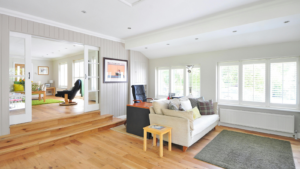
There’s more to walls than just paint or wallpaper. Enter the world of wood designs, where ordinary walls transform into extraordinary centerpieces.
Let’s explore the myriad of possibilities that this humble material offers, turning every wall into a masterpiece.
Wood Designs for Walls
As the modern trend continues, it’s impossible not to notice the growing appreciation for wood designs in interiors, breathing life into living spaces with its unique textures and patterns. Accentuating walls with various styles of wood designs, from rustic to contemporary, introduces a character that feels both luxurious and comfortable.
Types of Wood Designs for Walls
In modern interior spaces, various wood designs emerge as popular choices for walls. Each type offers unique aesthetics and texture, providing limitless opportunities for home and business owners. This section shepherds you through three prevalent iterations of wood designs for walls – Wood Paneling, Wood Cladding, and Carved Wood Art.
Wood Paneling

Wood paneling stands as an extolled choice for wall designs in the present era. Deriving its roots from the 16th century, it gets a modern makeover with styles ranging from rustic to sleek. Dominated by the design of long, thin strips of wood, paneling may be arranged horizontally, vertically, or in creative geometric patterns. Not only does it add a touch of warmth, but paneling also offers acoustic benefits, enhancing room sound quality.
Some iconic types include ship lap with its overlapping design, beadboard for its decorative effects, and V-grooved paneling. A study conducted by the Forest Products Laboratory shows that wood paneling possesses commendable dimensional stability and resistance to warping or twisting.1
Wood Cladding
Wood cladding refers to a type of design where exterior timber or lumber is affixed to walls. As documented by the Canadian Wood Council, it’s renowned for its exceptional insulating and aesthetic properties2. Wood cladding offers superior heat insulation, saving homeowners on heating bills in the colder months. It’s a design championed for its transformative power, converting bland walls into vibrant, textured surfaces.
Carved Wood Art
Carved wood art infuses an air of luxury and sophistication onto wall designs. Intricate carvings can become standalone pieces of wall art, often acting as focal points in a room. This type of design traces its lineage to early civilizations where it featured in sacred spaces and constructions.
Examples of carved wood art encompass relief sculptures, roundels, and bespoke decorative wall panels. Often handcrafted using various species of wood, each piece carries its unique grain and character, making it a one-of-a-kind creation. As stated by Sculpture Magazine, carved wood art embodies a significant part of our cultural heritage and continues to thrive in the modern age.
Cost-Effectiveness of Wood Designs

Wood, a popular choice in interior design, presents various financial aspects to consider. This section analyses the cost-effectiveness of wood designs for walls, considering factors like the initial investment and longevity, with pointers on potential savings.
Comparing Initial Investment and Longevity
While the upfront costs of wood designs might seem steep, their longevity assures it’s a sound investment. Hardwood types like oak or walnut, recognized for their durability, often last for generations. A homeowner might spend $5 to $10 per square foot for materials and installation, but with minimal maintenance work and their potential to last for decades, these designs offer exceptional value.
Ways to Save on Wood Wall Designs

Securing savings on wood wall designs doesn’t equate to compromising on quality; it implies smart purchasing and careful maintenance. Buyers can find reasonably priced quality woods in places like reclaimed lumber yards or a surplus home center, or by taking advantage of seasonal sales from large retailers.
Must Know
Wood designs for walls have emerged as a stylish and durable choice for modern interiors. They’ve been shown to offer exceptional value for money due to their longevity and minimal maintenance needs. By choosing hardwood types like oak or walnut, homeowners can enjoy these designs for decades. The article’s tips on smart purchasing, regular upkeep, and professional installation further enhance the cost-effectiveness of this trend.
